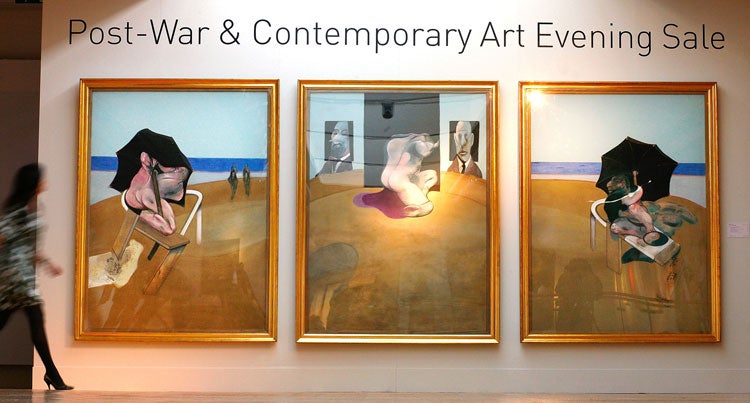Bacon's homage to dead lover sells for £26m

Your support helps us to tell the story
From reproductive rights to climate change to Big Tech, The Independent is on the ground when the story is developing. Whether it's investigating the financials of Elon Musk's pro-Trump PAC or producing our latest documentary, 'The A Word', which shines a light on the American women fighting for reproductive rights, we know how important it is to parse out the facts from the messaging.
At such a critical moment in US history, we need reporters on the ground. Your donation allows us to keep sending journalists to speak to both sides of the story.
The Independent is trusted by Americans across the entire political spectrum. And unlike many other quality news outlets, we choose not to lock Americans out of our reporting and analysis with paywalls. We believe quality journalism should be available to everyone, paid for by those who can afford it.
Your support makes all the difference.A "unique" painting revealing Francis Bacon's abject grief at the suicide of his lover, George Dyer, sold last night for more than £26m but failed to break the record for the artist's work by £150,000.
Triptych 1974-77, which had never before appeared on the open market and was in private hands, went to an anonymous buyer for £26.34m in a sale of post-war and contemporary art at Christie's. The sum is a European auction record for any post-war artwork.
Bacon, the Dublin-born artist who died in 1992, already holds the record for an auction sale of any Irish or British work for his 1962 painting Study From Innocent X, which fetched more than £26m in May.
Christie's had set its estimate for Triptych 1974-77 at £25m, the highest ever for a work of art in Europe. The sale price will help to confound expectations of a financial downturn in the art market, despite the raft of sales taking place this month. A Christie's auction earlier this week made a total of £105m, while one at Sotheby's achieved a record of more than £115m.
"Christie's established the highest price for any Post-War and Contemporary work of art sold in Europe this evening, with the superb result for the Triptych 1974-77 by Francis Bacon," said Pilar Ordovas, Head of Post-War and Contemporary Art at Christie's London.
Triptych 1974-77 is one of several pictures Bacon painted in response to the suicide of his lover in 1971. It contains brooding images of dark umbrellas and a writhing figure on a beach.
Dyer killed himself on the eve of a seminal Bacon show in Paris, in the hotel room they shared. Many of Bacon's later works were preoccupied with Dyer's death. The piece sold last night, the fourth and last in his Black Triptychs series, differs from predecessors in that it expresses a sense of hope. None of the others have appeared on the open market and only one is in private hands.
The stormy relationship between Bacon and his lover is said to have begun after he caught Dyer burgling his apartment in 1964. It ended less than a decade later when Dyer took an overdose. Both men were to attend Bacon's exhibition opening at the Grand Palais in Paris, but when Bacon returned to their room after leaving Dyer for a few hours, he found his partner dead.
Bacon became obsessed by Dyer's memory. In interviews with his friend, the critic David Sylvester, he said the paintings of Dyer in the four years after his suicide were a "conscious act of exorcism". In Michael Peppiatt's book on Bacon, Anatomy Of An Enigma, the artist said: "If I had never gone out that morning, if I had simply stayed and made sure he was all right, he may have been around now."
Later this month, a 1969 work by Bacon, Study Of A Nude With Figure In A Mirror, is expected to sell for between £18m and £25m at Sotheby's. A Bacon piece showing a bullfight was the star lot of last November's post-war art auction for Sotheby's, selling for £23m.
Interest in Bacon's work will be stimulated again in October when the Tate gallery hosts a retrospective commemorating his centenary next year.
Join our commenting forum
Join thought-provoking conversations, follow other Independent readers and see their replies
Comments